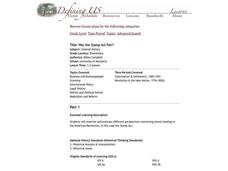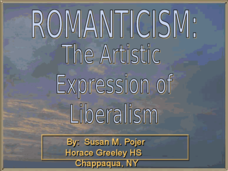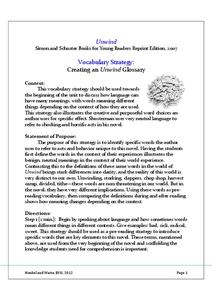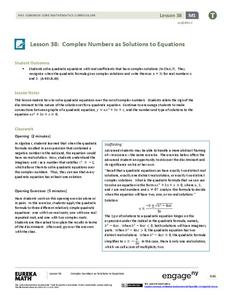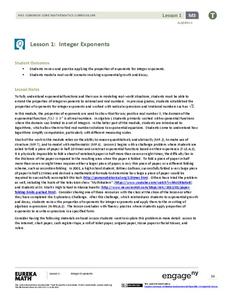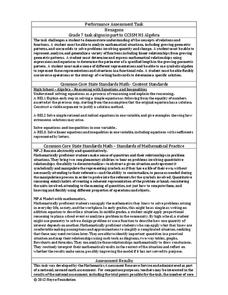Seattle Civil Rights and Labor History Project
Dr. Martin Luther King's Visit to Seattle
How was the work of Dr. Martin Luther King Jr. viewed by others during the 1960s? After watching an oral history video, your class members will learn more about Dr. King's ability to personally connect with others, as well as...
Curated OER
Was the Stamp Act Fair?
Elementary and middle schoolers examine and evaluate different perspectives concerning events leading to the American Revolution. In this case, they hone in on the Stamp Act. They research controversial bills, laws, or events of the time...
Defining US
Integration of Education and American Society
How did the struggle for Civil Rights during the 1950s transform American society and politics? Why are American schools integrated today? Class members explore these essential questions by examining a series of primary and secondary...
Curated OER
College Level Study Guide
In this study guide worksheet, students examine and complete questions that are similar to the college Accuplacer College Level Math test. This worksheet includes, but is not limited to, factoring and expanding polynomials, simplifying...
Ohio Department of Education
The Solution is Complex
Consider complex numbers, roots, and quadratic equations. Use the discriminate as a way to determine the nature of a quadratic's roots. Then discuss the similarities and differences between quadratics with two, one, or no real roots....
Curated OER
Cutting Corners - Parts 1 and 2
Students use optimization concepts to design their own container. In this optimization lesson plan, students understand how the optimization concept is critical in calculus and why products are packaged the way they are.
Curated OER
With Malice toward None: Lincoln's Assassination
Students analyze primary documents regarding Lincoln's assassination. In this lesson on Lincoln's assassination, students analyze three primary sources of information regarding President Lincoln's assassination.
Curated OER
The Dutch
Before seeing this presentation, your class might not have a grasp of the contributions to art, science, and politics made by the Dutch in the 16th and 17th centuries. Comprehensive and engaging, the many images and discussion points in...
Curated OER
Romanticism: The Artistic Expression of Liberalism
The epic clash of reason and emotion comes to life in this informative presentation. Detailing the period of Romanticism in 19th century Europe, these slides contain pictures of the most famous pieces of art during this period. Viewers...
Curated OER
The Revolutions of 1848
1848 was a hot year for Europe, which endured political tumult and upheaval after years of tension buildup. This presentation details the circumstances surrounding revolutions in France, Austria-Hungary, Romania, Italy, Prussia, and...
Curated OER
Revolution in China
There have been a lot of changes in China over the last century. This presentation begins with the fall of the Qing Dynasty and the revolution that led to the adoption of Communism. It highlights the Republican Revolution, Chinese...
Curated OER
What is Small Group Interaction?
While all learners need to know the benefits and responsibilities of working in a small group, this presentation and its vocabulary are geared toward a late high school or early college student. Why do we study in small groups? Why do...
Curated OER
For the Love of Publication!
What is a ‘Zine? Although the referenced PBS video that launches this study of self-published magazines is not available, the activities detailed and the step-by-step directions for creating ‘Zines would engage young writers. This...
Curated OER
Unwind: Vocabulary Strategy, Creating an Unwind Glossary
Prior to reading Unwind, Neal Shusterman's 2007 young adult science fiction novel, class members research the common definition of words drawn from the novel that will come to have a very different meaning to them as they are...
Curated OER
Intelligence in the Internet Age
Does technology affect our intelligence? Stefanie Olsen's article, "Intelligence in the Internet Age," and the thought provoking reading comprehension questions that follow, are sure to generate a lively discussion.
Curated OER
Lincoln is in the House! ("Name-Dropping" Poems and the Power of Connotation)
“What’s in a name?” Just about everything. Barack Obama, Vincent van Gogh, Justin Bieber. Famous names evoke a multitude of reactions and poets often use the names of famous people in their works precisely because names carry...
Sociology Central
Society Is Like...
To introduce the idea of different theoretical views about the nature of society, class members engage in a sociology activity that asks them to create an analogy between society and another concept, and then to explain the parallels.
Saddleback College
How to Find the Main Idea
What's the difference between the main idea of a text and the topic? Take kids through the process of literary analysis with a presentation about finding the main idea and supporting details. Additionally, it guides learners through...
Read Works
Plymouth Colony
Read about the tumultuous beginning to the United States with an informational text passage about Colonial America. As young researchers peruse an article about the arrival of the Mayflower, the settlers' relationship to the neighboring...
Willow Tree
Linear Relationships
There's just something special about lines in algebra. Introduce your classes to linear equations by analyzing the linear relationship. Young mathematicians use input/output pairs to determine the slope and the slope-intercept formula to...
EngageNY
Complex Numbers as Solutions to Equations
Quadratic solutions come in all shapes and sizes, so help your classes find the right one! Learners use the quadratic formula to find solutions for quadratic equations. Solutions vary from one, two, and complex.
EngageNY
Integer Exponents
Fold, fold, and fold some more. In the first installment of a 35-part module, young mathematicians fold a piece of paper in half until it can not be folded any more. They use the results of this activity to develop functions for the area...
Inside Mathematics
Hexagons
Scholars find a pattern from a geometric sequence and write the formula for extending it. The worksheet includes a table to complete plus four analysis questions. It concludes with instructional implications for the teacher.
Inside Mathematics
Magic Squares
Prompt scholars to complete a magic square using only variables. Then they can attempt to solve a numerical magic square using algebra.
Other popular searches
- Simplifying Radicals
- Radical Expressions
- Radical Equations
- Simplify Radicals
- Simplify Radical Expressions
- Operations With Radicals
- Solving Radical Equations
- Algebra Radical Expressions
- Free Radicals
- Multiplying Radicals
- Binomial Radical Expressions
- Radical Functions

